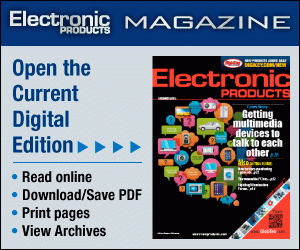Digital power modules deliver for advanced apps
Encapsulated digital power module technology combine next-gen package technology and digital power management
BY JOSH BROLINE
Intersil
www.intersil.com/powermodules
More and more industrial and communications applications can finally take advantage of the benefits of nonisolated dc/dc power supply modules, including higher reliability and smaller form factors, which can help shorten total end-product time to market and reduce the need for manufacturers to develop power design expertise. The dc/dc power modules can increase a design’s portability, while reducing its size. The module can deliver a complete, integrated solution, incorporating passives, inductors, MOSFET, and controller. It also offers a complete range of current and voltages in rugged, standard packaging at a reasonable cost.
The power module combines most or all of the components needed to deliver a plug-and-play solution that can replace up to 40 different components. This integration simplifies and speeds designs. It also significantly reduces the total power management footprint. The modules can be placed on the printed-circuit board close to the circuits they power, which aids in voltage regulation. Placement becomes even more critical as subsystems operate at higher currents, lower voltages, and higher clock frequencies.
In evaluating the different module options, engineers must compare their specific application requirements with a module’s electrical and thermal performance, physical dimensions, and reliability specifications available from traditional and emerging, higher-power-density options with optimal thermal resistivity.
The most common of the nonisolated dc/dc power modules are single in-line packages (SIP), open-frame solutions that can simplify design. But they typically are useful for lower frequency systems, for example, in the 600-kHz range and below. Also, their power density is not optimal, particularly in comparison with dc/dc encapsulated modules.
Fully encapsulated modules
The newest form of the power module is the fully encapsulated dc/dc PoL digital power module supply, which delivers the ultimate combination of advantages provided by a digital power solution via the PMBus and encapsulated module packaging. Enabled by the internal digital controller, the PMBus can be used to configure a wide variety of parameters to quickly adapt to specific application needs.
Various parameters can be monitored and stored in on-board nonvolatile memory, and as with most advanced modules, almost all discrete components are integrated. Advantages can include reduced time to market, minimized BOM on the PCB, and increased long-term reliability.
Enhanced fully encapsulated packaging provides large thermal pads on the bottom of the package for enhanced thermal capability and exposed leads around the edge of the package for ideal solder joint inspectability. With the ability to run off 3.3-, 5-, and 12-V bias rails and output a voltage from 0.54 to 4 V, with a single resistor setting, and up to 12-A output current, a fully encapsulated digital module is versatile enough to meet a fairly wide range of application requirements.
One of the major advantages of an encapsulated digital power module is superior power density enabled by improving package thermal performance. Power density and thermal resistivity of the package go hand in hand, especially when considering a high power solution, defined as greater than 10 W. There has been a race to improve density/integration for decades in the semiconductor industry.
The motivation is that systems are growing in functionality, which can require more components while the overall system size is being reduced to stay competitive. So component/solution size is a key part of this trend, which means higher-power-density or smaller-form-factor solutions can help designers fit more content or a higher/larger power processor, for example, on a PCB.
The lower the thermal resistivity, the higher the possible power density — some encapsulated module solutions struggle to meet higher power levels due to their package thermal resistivity. Also, the more thermally efficient the solution is, the less a user needs to be concerned with or design around the solution constraints, such as ensuring there is a specific amount of air flow, or adding a heat sink. Optimal thermal performance is enabled by the enhanced encapsulated QFN package with the large pads on the bottom of the package and the thermally enhanced package overmold material that spreads the heat.

Fig. 1: Benefits of the heat-spreading effect in encapsulated module.
Very low package thermal resistivity can be demonstrated by a package theta junction-to-ambient of 11.5 C/W and bottom of the package theta junction-to-case of 2.2 C/W. As a result, a higher-power solution can be designed in a smaller form factor. Because the theta JC on the backside of the package is so low, the majority of the heat is dissipated through the bottom of the package (see Fig. 1 ).
In contrast to an open-framed module, no air flow is required to run at full load over the industrial ambient temperature range in most operating conditions. The thermal capability of a module package has a major influence in achieving a higher power density versus more traditional open-framed modules or discrete power solutions, and makes the encapsulated module a solid choice to replace either.
Figure 1 shows the infared thermal images of a non-encapsulated module (left) and fully encapsulated module (right) mounted on equivalent PCB boards. The plastic molding around the internal components in the right-hand picture acts as a heat spreader and effectively reduces the internal temperature of the components. Since open-framed modules or discrete solutions do not have an overmold material, there is a higher level of power dissipation to the surrounding environment and often air flow is required to dissipate that heat similar to what the encapsulated material is doing in this example.
Encapsulated module solutions help drive toward higher reliability and manufacturability, due to their mechanical structure. For example, since all the components are fully encapsulated, there is better electrical isolation from the outside world, fewer solder joints that can open or short over time, and a lower chance of stresses in a given application causing package cracks Also, improved manufacturability can be realized since the encapsulated package is more conducive to traditional pick-and-place equipment versus a non-planar open framed solutions.
Another advantage of this kind of module comes in the ability to configure and monitor digital power management using the PMBus and I2 C interface. The best way to achieve these benefits is through a simple graphical user interface that lets designers adjust various operating parameters such as soft start ramp time, output voltage margining, voltage tracking and power-good threshold. No external circuitry is required using this method, and it is designed to be flexible enough to meet current and future design requirements.
Various parameters can be monitored during the system development stage and after the system is deployed out to the field. For example, the output conditions voltage and current can be monitored and stored in the internal nonvolatile memory with a date stamp on a regular basis and read back externally as needed. This enhances system design by speeding up debugging time and increases long-term system reliability by insuring normal operation at all times or enhancing failure analysis if a system is returned. Once a configuration is finalized for a specific application, the config file is produced by using the configuration program.
Significant advances in power density
As an example of the newest dc/dc encapsulated power module, the ZL9101MIRZ from Intersil offers a very unique combination of next generation package technology and easy to use digital power management that will simplify sophisticated PoL power supply design due to minimal external components, improve reliability over traditional open framed modules or discrete solutions, and improve design cycle time or time to market. It applies a system called PowerNavigator with the PMBus and a GUI to simplify and optimize configuration and monitoring.
Encapsulated modules in some cases can have four times higher power density. For example, comparing the Intersil ZL9101MIRZ to an equivalent open-frame module on the market, the ZL9101M has a power density of 38 W/cm3 versus 8.6 W/cm3 , over three times higher than this equivalent open-framed module at the equivalent output power level of 30 W. There is also a significant difference in the footprint of the two solutions, 2.2 cm2 versus 3 cm2 , a 30% difference, which is critical when board space is at a premium.
Encapsulated digital power module technology offers an advantageous combination of next- generation package technology and easily implemented digital power management that will simplify PoL power supply design with minimal external components, improved reliability over traditional open framed modules or discrete solutions, and enhanced design cycle time. ■
Advertisement
Learn more about Intersil





